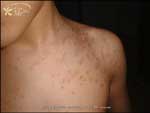|
|
 |

Abnormal |
| |
-
Pityriasis rosea is a self-limiting, salmon-colored patch that is followed by a spreading rash. The lesions are 1-2 cm in diameter, and are firmly attached at their borders and loose in the center, which gives them a cigarette-paper appearance. They last from 4-12 weeks, occurring more often in spring and fall.
|
 |
- A patch (herald) may appear days to weeks before the rash.
- Mainly on the trunk, sparing the hands, feet, and face
- Rash is rose-red to brownish-red oval spots that have a fine, scaly appearance with near clear centers.
- Itching is mild but can be severe.
- Rarely vesicles (fluid filled raised lesions) or larger lesions are seen.
- Fever and fatigue rare
|
 |
- Etiology unknown
- Viruses may play a role
|
 |
- Symptoms
- Illnesses
- Habits
- Drugs
- Medications
- Surgeries
- Allergies
- Family
- Your doctor may consult with a dermatologist (skin specialist).
- General exam
- Skin examined
- Scraping of the rash can be stained with KOH to see if fungi are present.
- Blood tests may be done if other diseases are suspected (such as Syphilis).
- Biopsy -- a piece of lesion can be scraped off or cut and sent for examination under a microscope.
|
 |
- None
- Does not seem to be contagious
|
 |
- Symptomatic treatment only
- Itching:
- Oatmeal baths -- warm water and oatmeal can be mixed and applied to skin.
- Antihistamines such as Benadryl can help.
- Steroid creams such as Triamcinolone work well in areas that are irritated and itching.
- Ultra Violet light therapy may help certain patients.
- Follow up with the doctor in 1-2 weeks after the visit if rash is still present.
|
 |
-
Contact the doctor for an exam.
|
| | |
If you want your friend to read or know about this article, Click here
 |
|
|

